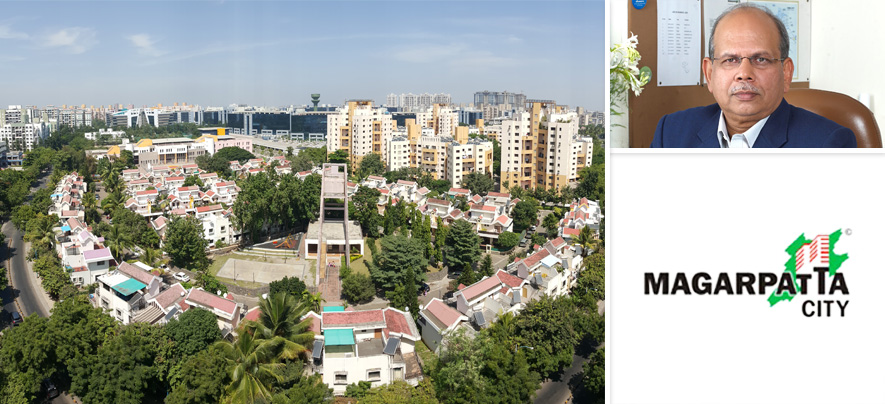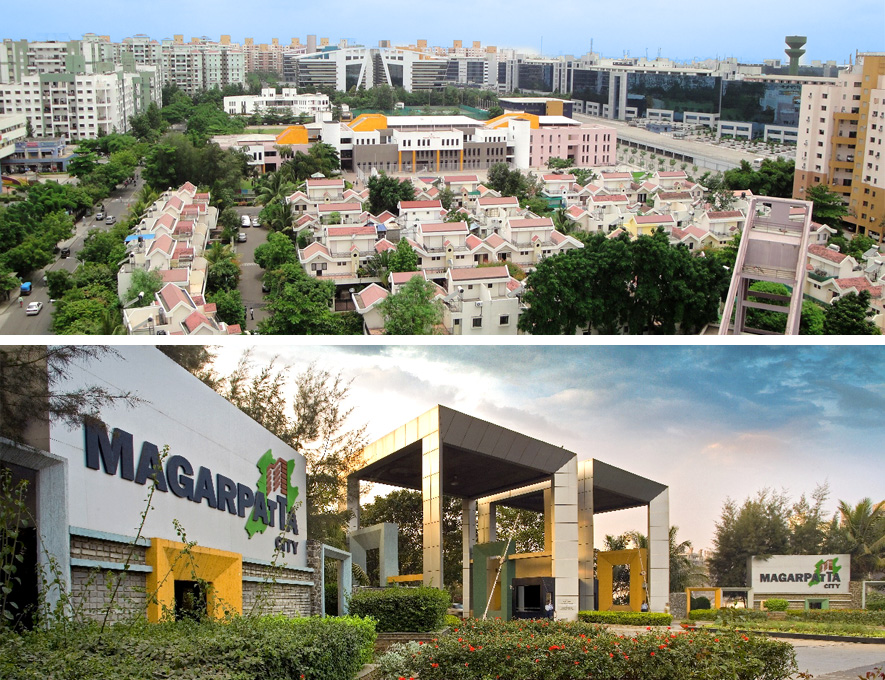A Visionary Entrepreneur Who Empowered More than 120 Farmers to Become Millionaires

Cảm hứng SME
462 tuần trước — 10 phút đọc
Satish Magar, Chairman & MD, Magarpatta Township Development & Construction Company Ltd, Pune
While India boasts of several thousand entrepreneurs, there are few that can claim to have the kind of grand vision and foresight that defines Satish Magar. Having envisioned and built a one of its kind township of 430 acres, Satish has not only provided a new way of living to 120 farmer families, but has also empowered these families by making them shareholders for their contribution of land in Magarpatta City.
Magarpatta City epitomises well-planned urban development and cooperative growth, contributing to collective social and financial development of farmers. A walk-to-all-destinations township, it boasts of a commercial zone, residential neighbourhoods, schools, a multi-speciality hospital, a shopping mall, multiple restaurants, a gymkhana and a 25-acre central garden. It is the only fully sustainable and privately managed township in the country. Maharashtra Economic Development Council’s recognition of Magarpatta City as one of the 'Top 10 Success Stories of the State' is a testimony to Satish Magar’s grand vision and execution.
In a conversation with GlobalLinker (GL), Satish Magar (SM), traces the birth & development of Magarpatta City and shares how the model of cooperative growth has benefitted hundreds of farmers and landholders.
Excerpts from the interview:
GL: Please share with us how you envisioned the idea of Magarpatta City and brought it to life? When did it all begin and how has the journey been so far?
SM: The land in Magarpatta, originally an agricultural land, was under the jurisdiction of the Pune Municipal Corporation. Around 1987, a lot of unauthorised construction had started in Pune at great speed including our surroundings. So, in order to protect our land and get the maximum valuation from it, the idea of Magarpatta City was born. Many wondered whether we should build golf courses, villas, an industrial or IT township. With Dr Vijay Bhatkar’s prediction of India to become an outsourcing hub, we decided to focus on creating an IT township. Additional factors that contributed to this decision were considerations of Pune having a strong education base, good English speaking population and close proximity to Mumbai.
The idea was to create, as that was the turn of the millennium, a network society – a new way of life in the new millennium. We focused on 5 aspects to provide this new way of living – environment; better living standards; modern educational system; state-of-the-art working conditions and security.
GL: What have been your early influences?
SM: We studied many development models before taking up the project. We studied Chandigarh, which is a planned city. But we decided not to draw inspiration from Chandigarh as it has sectors, crossroads, and house numbers, which we thought were mechanical. Instead, we explored Bangalore, New Delhi and Silicon Valley. These areas inspired me. Additionally, we wanted to make Magarpatta City accessible to all, and accordingly we drew inspiration from Singapore’s handicapped-friendly solutions. We studied these cities and adopted the best practices and learnings from all these cities.
GL: What inspired you to come up with such an ambitious project? There must have been naysayers along the way. What kept you going?
SM: Of course, people kept saying that it wouldn’t work. I think that was the driving force to ensure that it works because this was the first time when a 430-acre township in the private sector was planned anywhere in the state. Additionally, it was also the first time that farmers had come together as stakeholders in a company, and I was determined to make this model a success.
GL: Magarpatta is a unique concept of collective, cooperative growth. Tell us more about the concept of making the farmland owners stakeholders in this project.
SM: My family has lived in this area for generations. My forefathers were into agriculture for decades. I was born here. I am not an outsider and I never thought of buying any land at any point of time because we had seen several farmers going bankrupt within no time after selling off their land. What happens is when farmers sell their land, they don’t know what to do with the money. They are not prepared or oriented to handle such big amounts, and as a result, they end up losing this money.
I was committed to providing a better livelihood to farmers in lieu of their land. This is how our unique business model was born, where farmers can come together, pool their land and get the upside of the appreciation. Given they are stakeholders of the company; they share the profits too.
GL: What were some of the major challenges that you faced along the way?
SM: There were no major challenges faced from the farmers, as that was the time, after 1987, when there had been instances of farmers spending all the money they got after selling their land. With no money left, female members of their families had started working as domestic helpers in the buildings, which were constructed on their land. Farmers were very forthcoming and supportive of our business model.
The only challenge we faced was the lack of acceptability, as this was a unique and a new model. It took us about 7 years to get approvals. But this is not a very long period, considering the size and scope of the project.
GL: How did you utilise the 7 years of waiting time for approvals?
SM: Since no development can start till you get approvals, we leveraged this time gainfully by training the farmers to become entrepreneurs. We trained them onsite and learnt about their skills by conducting aptitude tests. We worked on how they would benefit from the project and on inculcating entrepreneurial qualities in them. People were sent to various institutes for training in construction. There was a lot of backward integration that we did and created an aspiring model. We also used this time to put together a team of experts – architects, space designers, landscaping consultants and technical consultants from Pune.
GL: You have created several corporations to ensure the smooth running of this city. Tell us a little about this aspect of the project.
SM: When we started doing this project, we began to understand the intricacies involved in it. We created a property management services division to take care of the entire township – management, maintenance, and security among others. For the people living here, we also formed a citizens’ council so that they can take part in the management process in one way or the other.
GL: You had a grand vision. What are the results of this vision and your early efforts today?
SM: The result is for all of us to see. Magarpatta is a totally self-sustained township. We have zero garbage, as everything is recycled. From managing power to water supply to recycling, people live and work here. Children go to school here, so it is totally integrated and self-sustaining. We also have solar panels, which are, for now, used for heating water.
GL: How are the second-generation farmers contributing to the township?
SM: The children are being educated in good schools, which are inside the campus. Education is playing a major role in their overall development. They now have several vocation options to choose from, and opportunities to start their own business. So, it has not only been a financial change to the lives of farmers but also an overall social change.
GL: Magarpatta is a visionary initiative. Are more such farmers and families going to benefit from your vision?
SM: Yes, we have two projects in Pune underway – ‘Nanded City’ on Sinhagad Road is under construction - and the proposed – ‘River View City’. Nanded City is almost double the size of Magarpatta City at 700 acres. The first phase is already completed with more than 7,000 families living there.
GL: If you had to do it all over again, what would you do differently?
SM: Technology is the only thing, which I would include if I had to do things again differently. For instance, in the second project, we have adopted a lot of modern technology in construction. The speed of construction has been better due to automation. Every project is a new learning, as so much change is happening which can be incorporated.
GL: What is your mantra for success?
SM: I believe you just have to work hard and there is no other way. Believe in what you are doing and keep on doing it. Stay persistent.
GL: What is your message to aspiring entrepreneurs?
SM: It’s very simple. What you could do yesterday is not what you can do today, because time has changed. You need to adapt to new technology, you need to be financially diligent and not take things for granted because the competition is severe and consumerism is the new mantra. The customer is becoming more and more vibrant and you just have to be customer centric.
Disclaimer: This article is based solely on the inputs shared by the featured member. GlobalLinker does not necessarily endorse the views, opinions & facts stated by the member.

Đăng bởi
GlobalLinker StaffWe are a team of experienced industry professionals committed to sharing our knowledge and skills with small & medium enterprises.
Xem trang cá nhân của GlobalLinker
Đọc nhiều nhất trong tuần này












Bình luận
Vui lòng Đăng nhập hoặc Đăng ký để tham gia bình luận